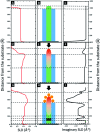Large area Al2O3-Au raspberry-like nanoclusters from iterative block-copolymer self-assembly
- PMID: 35519210
- PMCID: PMC9057902
- DOI: 10.1039/d0ra08730k
Large area Al2O3-Au raspberry-like nanoclusters from iterative block-copolymer self-assembly
Abstract
In the field of functional nanomaterials, core-satellite nanoclusters have recently elicited great interest due to their unique optoelectronic properties. However, core-satellite synthetic routes to date are hampered by delicate and multistep reaction conditions and no practical method has been reported for the ordering of these structures onto a surface monolayer. Herein we show a reproducible and simplified thin film process to fabricate bimetallic raspberry nanoclusters using block copolymer (BCP) lithography. The fabricated inorganic raspberry nanoclusters consisted of a ∼36 nm alumina core decorated with ∼15 nm Au satellites after infusing multilayer BCP nanopatterns. A series of cylindrical BCPs with different molecular weights allowed us to dial in specific nanodot periodicities (from 30 to 80 nm). Highly ordered BCP nanopatterns were then selectively infiltrated with alumina and Au species to develop multi-level bimetallic raspberry features. Microscopy and X-ray reflectivity analysis were used at each fabrication step to gain further mechanistic insights and understand the infiltration process. Furthermore, grazing-incidence small-angle X-ray scattering studies of infiltrated films confirmed the excellent order and vertical orientation over wafer scale areas of Al2O3/Au raspberry nanoclusters. We believe our work demonstrates a robust strategy towards designing hybrid nanoclusters since BCP blocks can be infiltrated with various low cost salt-based precursors. The highly controlled nanocluster strategy disclosed here could have wide ranging uses, in particular for metasurface and optical based sensor applications.
This journal is © The Royal Society of Chemistry.
Conflict of interest statement
There are no conflicts to declare.
Figures







Similar articles
-
Highly Ordered Porous Inorganic Structures via Block Copolymer Lithography: An Application of the Versatile and Selective Infiltration of the "Inverse" P2VP-b-PS System.ACS Appl Mater Interfaces. 2022 Aug 3;14(30):35265-35275. doi: 10.1021/acsami.2c10338. Epub 2022 Jul 25. ACS Appl Mater Interfaces. 2022. PMID: 35876355
-
Shear-Rolling Process for Unidirectionally and Perpendicularly Oriented Sub-10-nm Block Copolymer Patterns on the 4 in Scale.ACS Nano. 2021 May 25;15(5):8549-8558. doi: 10.1021/acsnano.1c00358. Epub 2021 May 12. ACS Nano. 2021. PMID: 33979144
-
Order quantification of hexagonal periodic arrays fabricated by in situ solvent-assisted nanoimprint lithography of block copolymers.Nanotechnology. 2014 May 2;25(17):175703. doi: 10.1088/0957-4484/25/17/175703. Epub 2014 Apr 10. Nanotechnology. 2014. PMID: 24722230
-
Interfacially formed organized planar inorganic, polymeric and composite nanostructures.Adv Colloid Interface Sci. 2004 Nov 29;111(1-2):79-116. doi: 10.1016/j.cis.2004.07.005. Adv Colloid Interface Sci. 2004. PMID: 15571664 Review.
-
Self-Assembled Block Copolymers as a Facile Pathway to Create Functional Nanobiosensor and Nanobiomaterial Surfaces.Polymers (Basel). 2024 May 1;16(9):1267. doi: 10.3390/polym16091267. Polymers (Basel). 2024. PMID: 38732737 Free PMC article. Review.
Cited by
-
Liquid Phase Infiltration of Block Copolymers.Polymers (Basel). 2022 Oct 14;14(20):4317. doi: 10.3390/polym14204317. Polymers (Basel). 2022. PMID: 36297895 Free PMC article. Review.
References
-
- Albella P. De La Osa R. A. Moreno F. Maier S. A. ACS Photonics. 2014;1:524–529. doi: 10.1021/ph500060s. - DOI
-
- Moskovits M. J. Raman Spectrosc. 2005;36:485–496. doi: 10.1002/jrs.1362. - DOI
-
- Adeyeye A. O. Singh N. J. Phys. D: Appl. Phys. 2008;41:153001. doi: 10.1088/0022-3727/41/15/153001. - DOI
-
- Maksymov I. S. Phys. Rev. A. 2016;1:36–51.
LinkOut - more resources
Full Text Sources

